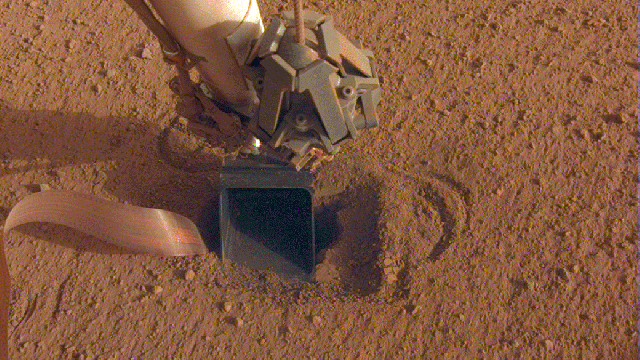After some mild progress, the Mars InSight heat probe, known as “the mole,” is no longer descending into the Red Planet. NASA is pressing pause on this part of the mission for now, freeing InSight’s robotic arm for other important jobs.
The saga of the self-hammering heat probe began in late February 2019, some 13 weeks after the InSight lander arrived on Mars. Unable to dig through the tough Martian regolith, mission planners devised a plan in which a scoop, located at the tip of InSight’s robotic arm, would pin the mole to the bottom of the pit, allowing it to resume its digging duties. This worked for a little while, but as NASA reports, the mole has stopped digging yet again.
Built by the German Aerospace Centre (DLR), the Heat Flow and Physical Properties Package is supposed to take an accurate temperature of Mars at depths reaching 10 feet (3 meters), but the mole hasn’t come close to this. The 16-inch (40 cm) heat probe has barely cleared the surface, despite months of work and hundreds of individual hammer strikes.
To burrow into Mars, the mole needs to be enveloped by loose regolith, but the surface material in this area appears to be duricrust, a cement-like mixture in which granules stick together.
Images taken during a hammering session on June 20 showed bits of Martian soil bouncing on the scoop — a possible sign that the mole is no longer digging and is now bouncing against the bottom of the pit and hitting InSight’s scoop. In a recent blog post, DLR instrument lead Tilman Spohn described the situation:
[When] we looked at the images that had been sent to Earth after the hammering session…we had to conclude that having the Mole two to three centimetres [0.75 to 1 inches] deeper in and below the surface was not providing the necessary friction, even when helped with pushing on the regolith. The tether moved back and forth and then to the left, reversing much of its forward progress from [before]. In the middle of the movie, one can see that the dust particles resumed moving. Two particles seem to even be jumping up some centimetres. But on closer inspection, one can see them rather moving forward from the interior of the scoop in several slides. The moving dust particles imply that the Mole had backed up again and was tapping on the flat side of the scoop from below.
This result of the ‘Free Mole Test’ was, of course, not quite what we had hoped for, but we cannot say that it came as a complete surprise. After all, we are continuing to fight against the missing friction on the Mole hull. The test supports our earlier conclusion that the cohesive duricrust is unusually thick — at least based on what we previously knew about Mars — and that it must be quite rigid.
It’s not helping that mission planners can’t even see the mole or the interior of the pit, as they are obscured by the scoop.
NASA is now pausing this part of the mission, making the scoop available for other tasks. While that happens, Spohn and his colleagues will mull over next possible steps, “although we appreciate that the task is not likely to become easier,” he wrote.
With InSight’s arm retracted, the team will take stereoscopic images of the pit with the mole inside, measure the depth of the probe, see how the shape of the pit might have changed on account of the last few hammering sessions, and determine if the mole’s activity has altered the distribution and composition of sand in the pit.
A possible next move might be to use InSight’s scoop to shove loose material into the hole, which could provide the needed friction. The scoop would then once again guard against the mole backing out of the hole. Spohn said that filling the pit won’t be an easy task, and it’ll likely take some time. He estimates that 300 cubic centimeters of sand will be needed. We’ll find out more in August, when the team reconvenes.
Now liberated from its mole duties, InSight will be commanded to take a selfie using a camera attached to its arm. In particular, NASA would like a shot of the machine’s solar panels to see how much dust has accumulated on top of them. This’ll give NASA a sense of how much daily power remains available to the stationary probe.
InSight will also use the arm to perform some astronomy. By tilting the camera upward, the probe will capture images of meteors streaking across the Martian night sky, allowing scientists to determine the rate at which meteorites hit the surface in this region of Mars. These observations will then be cross-referenced with data gathered by InSight’s seismometer, which has the primary duty of detecting Marsquakes.
Gotta say, the situation with the mole doesn’t look good. Obviously, the team must keep trying until no other avenues are available. At some point, however, they may have to give up and devote more time to other aspects of the mission, which, to be fair, has been a rousing success overall. For example, the first year of data revealed that, much like Earth, Mars is constantly odd pulses in the Martian magnetic field.
